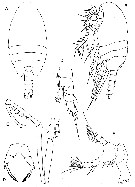|
|
 |
|
Calanoida ( Ordre ) |
|
|
|
Clausocalanoidea ( Superfamille ) |
|
|
| |
| | | |
| Mesaiokeratidae Matthews, 1961 ( Clausocalanoidea ) | | Ref.: | Matthews, 1961 (p.37,38); Bradford, 1969 b (p.502, Table 3); Andronov, 1974 a (p.1005, 1009); Fosshagen, 1978 (p.182: Definition); Razouls, 1982 (p.373); 1993 (p.310); Bowman & Abele, 1982 (p.9); Huys & Boxshall, 1991 (p.419); Bradford-Grieve, 1994 (p.133, Def.); Bradford-Grieve & al., 1999 (p.881, 902, 904, 935); Ohtsuka & Huys, 2001 (p.461); Boxshall & Halsey, 2004 (p.16; 49; 142: Def., Rem.: p.144); Vives & Shmeleva, 2007 (p.674)
Bradford-Grieve J.M., (2002 onwards). Key to calanoid copepod families. Version 1 : 2 oct 2002. http://www.crustacea.net/crustace/calanoida/index.htm  | | Rem.: | 1 G.: Mesaiokeras. |  issued from : E.L. Markhaseva & F.D. Ferrari in Invert. Zool., 2005, 2 (2). [p.162, Table 4] Setation of oral parts in females Mesaiokeratidae (Clausocalanoidea) and ancestral condition of setation. |
 Issued from : G.A. Boxshall & S.H. Halsey in An Introduction to Copepod Diversity. The Ray Society, 2004, No 166, Part. I. [p.142]. Armature formula of swimming legs P1 to P4. Setation sometimes reduced; outer spine on 1st and 2nd exopodal segments of P1 lacking in most species. Nota: Female typically asymmetrical with right leg missing and left leg rudimentary, 2-segmented, with 2nd segment forming a bifid process: rarely both legs present. - Male P5 asymmetical; right leg reduced to 1 to 3-segmented process; left leg elongate; comprising coxa, elongate basis and 3-segmented exopod; 2nd exopodal seglment sometimes armed with outer spine, ornamented with row of long spinules in Mesaiokeras mikhailini Andronov; distal segment with up to 2 inner elements. - Eggs released into water. |
 Issued from : G.A. Boxshall & S.H. Halsey in An Introduction to Copepod Diversity. The Ray Society, 2004, No 166, Part. I. [p.143, Fig.30]. Mesaiokeratidae. A, Mesaiokeras heptneri habitus female; B, habitus male (lateral); C, P1; D, female P5; E, male P5; F, Mesaiokeras kaufmanni male Md. [Andronov, 1973a: A-E; Fosshagen, 1978: F]. | | | | | (1) Mesaiokeras Matthews, 1961 | |
| | Ref.: | Matthews, 1961 (p.33, 38); Fosshagen, 1978 (p.183: Def.); Razouls, 1982 (p.373); Huys & Boxshall, 1991 (p.49, 324); Razouls, 1993 (p.310); Bradford-Grieve, 1994 (p.133, Def.); Mauchline, 1998 (p.87, 88: F; p.90: M); Bradford-Grieve & al., 1999 (p.935: spp. Key); Bradford-Grieve, 2004 (p.287); Boxshall & Halsey, 2004 (p.144, spp. Key); Vives & Shmeleva, 2007 (p.675, spp. Key) | | Rem.: | Formes hyperbenthiques.
A l'occasion de la description de ce nouveau genre, Matthews discute la validité des deux sections Amphascandria et Isokerandria.
La famille des Mesaiokeratidae présente des caractères qui l'apparente à celles des Scolecitrichidae et des Diaixidae.
Type: Mesaiokeras nanseni Matthews,1961. Total: 9 spp. | | Remarques sur les dimensions et le sex-ratio: | | The mean female size is 0.520 mm (n = 11, SD = 0.231), and the mean male size is 0.490 mm (n = 2, SD = 0.217). The size ratio male: female is 0.942.
If the arctic species (M. spitsbergensis Schulz & Kwasniewski, 2004) is not included, we obtain: mean size female: 0.420 mm (n = 9; SD = 0.0630), and mean male size 0.409 mm (n = 12; SD = 0.0735) and a size ratio male:female 0.973. | | | |
|
|
 Toute utilisation de ce site pour une publication sera mentionnée avec la référence suivante : Toute utilisation de ce site pour une publication sera mentionnée avec la référence suivante :
Razouls C., Desreumaux N., Kouwenberg J. et de Bovée F., 2005-2025. - Biodiversité des Copépodes planctoniques marins (morphologie, répartition géographique et données biologiques). Sorbonne Université, CNRS. Disponible sur http://copepodes.obs-banyuls.fr [Accédé le 02 janvier 2026] © copyright 2005-2025 Sorbonne Université, CNRS
|
|
 |
 |




